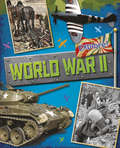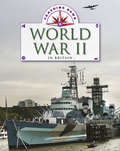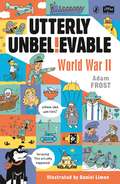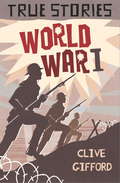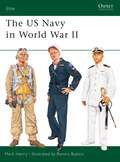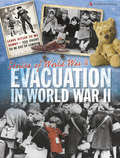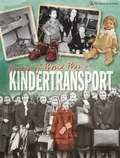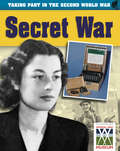Special Collections
World War 2
Description: books and accessible images to support themed learning about World War 2.
- Table View
- List View
World War Two
by Jane BinghamThis photographic book gives you an overview of World War Two. From how the war began to how it spread worldwide, the new technology that was used in war for the first time, how women's roles changed in society because of the war, what life was like on the home front, and how the war was recorded in pictures, diaries, poems and stories. You can learn about key figures, such as Winston Churchill, and events, such as The Holocaust. You can also read a diary entry from the Blitz and learn how to create your own secret code.
World War II in Britain
by Liz Gogerly'The past is all around us, if we know where to look.' This series takes a look at archaeological, structural and museum evidence from around Britain, allowing readers to build up a picture of what life was like in key historical periods and how you can discover it for yourself by visiting sites around the country.
Utterly Unbelievable
by Adam FrostPrepare to discover the most utterly unbelievable REAL facts about WWII . . . Did you know that onions were given as birthday presents in WWII? Or that exploding camel dung was used as a weapon? Could a leaky toilet force a submarine crew to abandon ship?This is history like you've never known it before! Ask yourself . . .Would you eat squirrel tail soup, cow's udders, or a carrot on a stick? Could you share 12.7cm of bathwater with your WHOLE family - for your weekly wash? If you were a spy, which gadgets and inventions would you choose?From flying tanks to Operation Toenail, read about the daring, tragic and heroic events that shaped one of the most influential conflicts in modern times. With a bold design and colourful illustrations, picture the most amazing, and unbelievable, facts from this world-changing time.Puffin and IWM (Imperial War Museums) are proud to be working together to educate and inspire young readers with tales from the past. Puffin know that stories can take you anywhere. As one of the most beloved children's publishers, we aim to fire every young imagination. Uncovering people's experiences during wartime, from the First World War to the present day, IWM is a family of five museums (IWM London, Churchill War Rooms, HMS Belfast, IWM North, and IWM Duxford).
World War II field gun (UEB uncontracted)
by RnibThis is an image of a side view of a large gun facing to the left and some of the shells it could fire. There is a locator dot shown, which will be at the top left of the page when the image is the correct way up. The muzzle is in the top left of the page and the gun barrel slopes down to the right. Halfway down it goes through a protective shield shown edge on. The breech is shown as a rectangle at the end of the barrel, where a shell would be loaded. Down from the breech is a circular handle which is used to change the angle of the barrel so the correct range is found. Down and to the left of the handle is one of the large wheels needed to move the gun from one battle to another. It has very knobbly tyres. It is attached to the gun carriage which is up and right from the wheel. The end of the carriage on the right is where the gun is hooked onto the vehicle to tow it. There are five shells standing vertically to the left of the gun and one, lying on its side, pointing to the right under the carriage to the right.
World War II German doodlebug (large print)
by RnibThis page shows two images of the flying bomb, the V1 nicknamed doodlebug. At the top of the page seen from the side and in the bottom and middle of the page a plan view seen from above. There is a locator dot shown, which will be at the top left of the page when the image is the correct way up. Both views have the front on the left and the tail on the right of the page. In the top side view the body of the flying bomb is fatter on the left than the right. It is very streamlined. Halfway along the body the end of the wing can be found. It is angled up slightly to give the bomb lift when it flies. The pulse jet engine on the right is mounted onto the top of the bomb by two brackets. The end of the engine on the left is for air intake and the end on the right is the exhaust thrust. In the plan view image in the bottom and middle of the page the body of the bomb goes from left to right in the centre of the image. The wings go up and down the page from the body. On each wing there is a German cross indicating the bomb belongs to the Luftwaffe. The upper surface is green although sometimes camouflage colours were used so it was difficult to spot from the air. The underneath colour is a pale sky colour so it would be difficult to spot from the ground when flying.
World War II German doodlebug (UEB contracted)
by RnibThis page shows two images of the flying bomb, the V1 nicknamed doodlebug. At the top of the page seen from the side and in the bottom and middle of the page a plan view seen from above. There is a locator dot shown, which will be at the top left of the page when the image is the correct way up. Both views have the front on the left and the tail on the right of the page. In the top side view the body of the flying bomb is fatter on the left than the right. It is very streamlined. Halfway along the body the end of the wing can be found. It is angled up slightly to give the bomb lift when it flies. The pulse jet engine on the right is mounted onto the top of the bomb by two brackets. The end of the engine on the left is for air intake and the end on the right is the exhaust thrust. In the plan view image in the bottom and middle of the page the body of the bomb goes from left to right in the centre of the image. The wings go up and down the page from the body. On each wing there is a German cross indicating the bomb belongs to the Luftwaffe. The upper surface is green although sometimes camouflage colours were used so it was difficult to spot from the air. The underneath colour is a pale sky colour so it would be difficult to spot from the ground when flying.
World War II German doodlebug (UEB uncontracted)
by RnibThis page shows two images of the flying bomb, the V1 nicknamed doodlebug. At the top of the page seen from the side and in the bottom and middle of the page a plan view seen from above. There is a locator dot shown, which will be at the top left of the page when the image is the correct way up. Both views have the front on the left and the tail on the right of the page. In the top side view the body of the flying bomb is fatter on the left than the right. It is very streamlined. Halfway along the body the end of the wing can be found. It is angled up slightly to give the bomb lift when it flies. The pulse jet engine on the right is mounted onto the top of the bomb by two brackets. The end of the engine on the left is for air intake and the end on the right is the exhaust thrust. In the plan view image in the bottom and middle of the page the body of the bomb goes from left to right in the centre of the image. The wings go up and down the page from the body. On each wing there is a German cross indicating the bomb belongs to the Luftwaffe. The upper surface is green although sometimes camouflage colours were used so it was difficult to spot from the air. The underneath colour is a pale sky colour so it would be difficult to spot from the ground when flying.
World War II field gun (UEB contracted)
by RnibThis is an image of a side view of a large gun facing to the left and some of the shells it could fire. There is a locator dot shown, which will be at the top left of the page when the image is the correct way up. The muzzle is in the top left of the page and the gun barrel slopes down to the right. Halfway down it goes through a protective shield shown edge on. The breech is shown as a rectangle at the end of the barrel, where a shell would be loaded. Down from the breech is a circular handle which is used to change the angle of the barrel so the correct range is found. Down and to the left of the handle is one of the large wheels needed to move the gun from one battle to another. It has very knobbly tyres. It is attached to the gun carriage which is up and right from the wheel. The end of the carriage on the right is where the gun is hooked onto the vehicle to tow it. There are five shells standing vertically to the left of the gun and one, lying on its side, pointing to the right under the carriage to the right.
World War II bren gun (UEB contracted)
by RnibThis is an image of a side view of a machine gun facing to the left. There is a locator dot shown, which will be at the top left of the page when the image is the correct way up. The muzzle is in the left of the page with the foresight sticking up from the barrel. The gun barrel goes right to the centre of the page. Just left of centre is a handle, it sticks up and right, the actual handle is nearly horizontal. To the right of this is a wide curved shape, also sticking up. This is the magazine full of bullets. The last thing sticking up on the right before the wooden butt is the back sight. Down and left from the butt on the right of the page is another wooden handle. To the left of it is an oval trigger guard and the trigger. On the left is a rod which goes down to the bottom left of the page. This is a rest stand to stabilise the gun when it is being fired. It can fold up to the right when the gun is being carried.
World War II evacuee children (large print)
by RnibThis page shows an image of three small children. There is a locator dot shown, which will be at the top left of the page when the image is the correct way up. The children are shown standing facing forwards so both their arms, legs, eyes and ears can be found. There is a girl on the left, a boy in the middle and a smaller girl on the right. They each wear a luggage label which says their name and where they are being evacuated to. The girl on the left wears a short orange coat and a pink bonnet. She has a white box containing her gas mask hanging on a string around her neck. She has short pale grey socks and red sandals. The boy in the middle wears a brown cap and a very short grey coat. He has long grey socks which are wrinkled as they are falling down. He wears brown shoes and his gas mask box is on the ground to the left of them and rhere is a suitcase ti the right of them. The girl on the right wears a light purple coat to below her knees. On her head she has a small brown hat. She also has a white box containing her gas mask hanging on a string around her neck. She wears short pale grey socks and brown shoes.
World War II evacuee children (UEB uncontracted)
by RnibThis page shows an image of three small children. There is a locator dot shown, which will be at the top left of the page when the image is the correct way up. The children are shown standing facing forwards so both their arms, legs, eyes and ears can be found. There is a girl on the left, a boy in the middle and a smaller girl on the right. They each wear a luggage label which says their name and where they are being evacuated to. The girl on the left wears a short orange coat and a pink bonnet. She has a white box containing her gas mask hanging on a string around her neck. She has short pale grey socks and red sandals. The boy in the middle wears a brown cap and a very short grey coat. He has long grey socks which are wrinkled as they are falling down. He wears brown shoes and his gas mask box is on the ground to the left of them and rhere is a suitcase ti the right of them. The girl on the right wears a light purple coat to below her knees. On her head she has a small brown hat. She also has a white box containing her gas mask hanging on a string around her neck. She wears short pale grey socks and brown shoes.
World War II gas mask (large print)
by RnibThis page shows an image of a man wearing a gas mask. There is a locator dot shown, which will be at the top left of the page when the image is the correct way up. Only his head and shoulders are shown facing forwards, surrounded by an image border. Some of his brown hair is shown at the top of the image. There are two gas mask straps going over the top of his head. His face is hidden by the body of the mask. His eyes can be found staring out through the eyepieces. An ear pokes out to the left and right. The gas mask filter hangs down from where his nose and mouth would be. The round end with small holes in and the some of the side is shown. It is like a wide round can. He wears a brown open necked shirt with one button showing.
World War II bren gun (UEB uncontracted)
by RnibThis is an image of a side view of a machine gun facing to the left. There is a locator dot shown, which will be at the top left of the page when the image is the correct way up. The muzzle is in the left of the page with the foresight sticking up from the barrel. The gun barrel goes right to the centre of the page. Just left of centre is a handle, it sticks up and right, the actual handle is nearly horizontal. To the right of this is a wide curved shape, also sticking up. This is the magazine full of bullets. The last thing sticking up on the right before the wooden butt is the back sight. Down and left from the butt on the right of the page is another wooden handle. To the left of it is an oval trigger guard and the trigger. On the left is a rod which goes down to the bottom left of the page. This is a rest stand to stabilise the gun when it is being fired. It can fold up to the right when the gun is being carried.
World War II field gun (large print)
by RnibThis is an image of a side view of a large gun facing to the left and some of the shells it could fire. There is a locator dot shown, which will be at the top left of the page when the image is the correct way up. The muzzle is in the top left of the page and the gun barrel slopes down to the right. Halfway down it goes through a protective shield shown edge on. The breech is shown as a rectangle at the end of the barrel, where a shell would be loaded. Down from the breech is a circular handle which is used to change the angle of the barrel so the correct range is found. Down and to the left of the handle is one of the large wheels needed to move the gun from one battle to another. It has very knobbly tyres. It is attached to the gun carriage which is up and right from the wheel. The end of the carriage on the right is where the gun is hooked onto the vehicle to tow it. There are five shells standing vertically to the left of the gun and one, lying on its side, pointing to the right under the carriage to the right.
World War II bren gun (large print)
by RnibThis is an image of a side view of a machine gun facing to the left. There is a locator dot shown, which will be at the top left of the page when the image is the correct way up. The muzzle is in the left of the page with the foresight sticking up from the barrel. The gun barrel goes right to the centre of the page. Just left of centre is a handle, it sticks up and right, the actual handle is nearly horizontal. To the right of this is a wide curved shape, also sticking up. This is the magazine full of bullets. The last thing sticking up on the right before the wooden butt is the back sight. Down and left from the butt on the right of the page is another wooden handle. To the left of it is an oval trigger guard and the trigger. On the left is a rod which goes down to the bottom left of the page. This is a rest stand to stabilise the gun when it is being fired. It can fold up to the right when the gun is being carried.
World War II gas mask (UEB uncontracted)
by RnibThis page shows an image of a man wearing a gas mask. There is a locator dot shown, which will be at the top left of the page when the image is the correct way up. Only his head and shoulders are shown facing forwards, surrounded by an image border. Some of his brown hair is shown at the top of the image. There are two gas mask straps going over the top of his head. His face is hidden by the body of the mask. His eyes can be found staring out through the eyepieces. An ear pokes out to the left and right. The gas mask filter hangs down from where his nose and mouth would be. The round end with small holes in and the some of the side is shown. It is like a wide round can. He wears a brown open necked shirt with one button showing.
World War One
by Clive GiffordThe book contains nine short stories dealing with different aspects of life during World War I.World War I includes the stories of flying aces such as the 'Red Baron', the story of Lawrence of Arabia and the stories of brave doctors and nurses such as Edith Cavell in German occupied Belgium.Complete with glossary, further reading section and index.
World War II gas mask (UEB uncontracted)
by RnibThis page shows an image of a man wearing a gas mask. There is a locator dot shown, which will be at the top left of the page when the image is the correct way up. Only his head and shoulders are shown facing forwards, surrounded by an image border. Some of his brown hair is shown at the top of the image. There are two gas mask straps going over the top of his head. His face is hidden by the body of the mask. His eyes can be found staring out through the eyepieces. An ear pokes out to the left and right. The gas mask filter hangs down from where his nose and mouth would be. The round end with small holes in and the some of the side is shown. It is like a wide round can. He wears a brown open necked shirt with one button showing.
Second World War Recruitment Poster - "Together" (tactile)
by RnibThis poster was used throughout the Empire and Commonwealth to recruit people to fight with Britain in the Second World War. Men and women came to the UK to work in industry, nursing and the armed forces as volunteers. Over 3 million people supported the UK in the armed forces of the Commonwealth. Almost 2.5 million Indians volunteered to help Britain fight. This is the largest volunteer army in history. Just under half of today's black and Asian population in the UK originate from cultural and ethnic groups that served and worked here during the Second World War. Description of the poster This coloured recruitment poster looks like a painting and shows seven fully uniformed members from the Commonwealth marching together under a flying Union Jack flag. The head-to-waist images of the men are shown in three diagonal rows - three at the front, two in the middle and two at the back. All are facing towards the right of the poster and are carrying rifles over their left shoulders with the rifle butt supported by their left hands. The front row, from left to right, has a Canadian airman (blue uniform), an Australian soldier (khaki uniform), and a British Navy sailor (navy uniform). The middle row, from left to right, has a South African soldier (cream uniform) and a New Zealand soldier (khaki uniform). The back row, from left to right, has a West African soldier (cream uniform) and an Indian soldier (khaki uniform). All men are white and clean-shaven, except the West African soldier, who is black, and the Indian soldier, who dark skinned with a beard. It is each man's uniform hat that distinguishes him and his country. Colour is used in the poster to represent the red, white and blue of the Union Jack and the colours on the men's uniforms. The poster has a white border with a large black band across the bottom that contains the word "together" in yellow capitals. The only other readable words on the poster are "Canada" on the sleeve badge of the Canadian airman and "H.M.S. Victory" on the headband of the British Navy sailor.
World War II evacuee children (UEB contracted)
by RnibThis page shows an image of three small children. There is a locator dot shown, which will be at the top left of the page when the image is the correct way up. The children are shown standing facing forwards so both their arms, legs, eyes and ears can be found. There is a girl on the left, a boy in the middle and a smaller girl on the right. They each wear a luggage label which says their name and where they are being evacuated to. The girl on the left wears a short orange coat and a pink bonnet. She has a white box containing her gas mask hanging on a string around her neck. She has short pale grey socks and red sandals. The boy in the middle wears a brown cap and a very short grey coat. He has long grey socks which are wrinkled as they are falling down. He wears brown shoes and his gas mask box is on the ground to the left of them and rhere is a suitcase ti the right of them. The girl on the right wears a light purple coat to below her knees. On her head she has a small brown hat. She also has a white box containing her gas mask hanging on a string around her neck. She wears short pale grey socks and brown shoes.
The US Navy in World War II
by Ramiro Bujeiro and Mark HenryIn 1941 the US Navy had 17 battleships of which eight would be knocked out on the first day of the war four aircraft carriers, and about 340,000 men including reservists. Pearl Harbor so weakened it that it was unable to prevent the Japanese capture of the Philippines and a vast sweep of Pacific islands. By 1945 it was the strongest navy the world had ever seen, with nearly 100 carriers, 41,000 aircraft and 3.3 million men; the unrivalled master of air-sea and amphibious operations, it was poised to invade Japan's home islands after reducing her fleet to scrap and her Pacific empire to impotence and starvation. This extraordinary story is illustrated here with dramatic photos, and nine meticulous colour plates showing a wide range of USN uniforms.
Evacuation
by A.J. StonesCan you imagine leaving your home and your family, and moving hundreds of miles away to live with strangers, because it was too dangerous to stay in your hometown? During World War II, this was situation millions of people, the majority of them children, faced. Stories of World War II: Evacuation tells the stories of these children: where they came from, where they went, who looked after them, what they ate, and how they went to school, along with many other details about their lives as evacuees.Much of the material on which the book is based comes from The National Archives, and so is made up of government documents and reports from during World War II. This gives the book a real grounding in fact and in history - it is a true account of what life was like for evacuees during World War II.The other book in the series, Stories of World War II: Kindertransport, tells the story of Jewish children evacuated to Britain from Germany, Holland and Austria before the outbreak of World War II.
Kindertransport
by A.J. StonesCan you imagine leaving your home and your family, and moving hundreds of miles away, to a different country, because it was too dangerous to stay in your own country? During World War II, this was the situation millions of people, many of them children, faced. Stories of World War II: Kindertransport tells the story of the Jewish children who left Germany, Austria, Czechoslovakia and Poland without their parents in 1939, before the outbreak of World War II, and came to Britain on the Kindertransport. The book explains what happened, why they had to leave their homes, how they came to Britain and what happened to them when they arrived. Much of the material on which the book is based comes from The National Archives, and so is made up of government documents and reports from during World War II. This gives the book a real grounding in fact and in history - it is a true account of what life was like for the children of the Kindertransport during World War II.The other book in the series, Stories of World War II: Evacuation, tells the story of children evacuated from British towns and cities to the countryside during World War II.
Secret War
by Ann KramerThis book looks at the many ways in which secret operations helped defeat the enemy during the Second World War. Taking Part in the Second World War offers a history of the war told through the words of the people who took part. Author Ann Kramer skilfully weaves the threads together to build up a portrait of not only the events of the war, but also of those who served future generations so well.
World War II German foot soldier (UEB uncontracted)
by RnibThis page shows an image of a soldier. There is a locator dot shown, which will be at the top left of the page when the image is the correct way up. The man is shown standing, from the front but with the head turned to the left so both arms and legs but only one eye and ear can be found. He wears a grey coloured uniform. He has a metal helmet on his head. His jacket has the flaps with buttons to two breast and two waist pockets showing. There is a decorative motive on each collar flap. Up from the breast pocket on the left there is the German military badge which is made from a bird and a swastika. There is a leather strap going from the shoulder on the left to the waist on the right. He has a leather belt with four leather pouches on it. His arms are straight and held out to the left and right. He wears trousers to just below the knee. He has long black leather boots on his feet.
